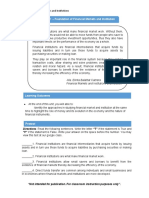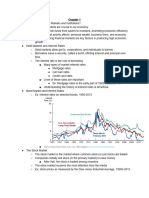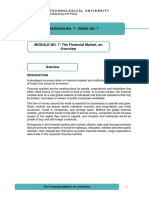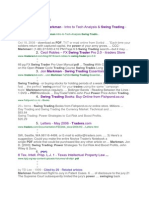Introduction to
Financial Markets & Institutions
Ahmed Aslam
PMP, MPM, ACCA
��INSTRUCTORS PROFILE
Ahmed Aslam
ahmed.aslam@szabist-isb.edu.pk
CREDENTIALS
Project Management Professional (PMP)
Project Management Institute, USA
Masters in Project Management (MPM)
Szabist, Islamabad
Chartered Certified Accountant (ACCA)
Association of Chartered Certified Accountants, UK
EXPERIENCE
Program Manager
Masters in Project Management Program at Szabist
Vice-President Strategy/PMP trainer
Project Management Institute Islamabad Chapter
�LETS BREAK THE ICE
�THE RULES
Class attendance
Max of 3 Absents/Leaves
Absent for late coming
Disqualification on 4th absent
Constructive discussion
Discussion driven lectures
Speak on your turn
No cross arguments
Use of Mobile phone
Strictly not allowed
Fine & confiscation
Breaks
20 mins at mid time
Be back on time
�CLASS REPRENSENTATIVE ?
Responsible for Information
exchange between the
instructor and students
Assist the Instructor for
managing & conducting the
class lecture
�ASSESSMENT CRITERIA
Pre-mid Quiz
5 marks
Pre-mid Project
10 marks
Mid-term exam
30 marks
Post-mid Quiz
Post-mid Project
5 marks
10 marks
Final exam
40 marks
TOTAL
100 marks
�COURSE OUTLINE
o
o
o
o
o
o
o
o
o
o
o
o
o
o
o
Week 01 Introduction to Financial Markets & Institutions
Week 02 Overview of the financial system
Week 03 Types of interest Rates
Week 04 The bond market
Week 05 Changing interest rates
Week 06 Quiz & Presentations
Week 07 Mid-term Examination
Week 08 - Post Mid-term evaluation
Week 09 - Risk structure & interest rates
Week 10 - The stock market
Week 11 - The money market
Week 12 - Existence of financial institutions
Week 13 - The mutual funds industry
Week 14 Quiz & Presentations
Week 15 Revision
Week 16 - Final Examination
�LECTURE OUTLINE
Financial Markets
Debt markets & Interest rates
The stock market
The foreign exchange market
Financial Institutions
Structure of the financial system
Financial crisis
Central banks and monetary policy
International Financial system
Banks & Other Financial institution
Financial Innovation
Managing risk in Financial institution
�Debt Market and Interest Rate
Debt
A sum of money borrowed or owed
Debt market
A financial market where you buy & sell debt
Security
A financial instrument which claims issuers future income
Bond
A debt security making payments periodically over time
Interest Rate
Cost of borrowing money expressed as a percentage
�The Stock Market
A common stock (typically just called a stock) represents a
share of ownership in a corporation. It is a security that is a
claim on the earnings and assets of the corporation. Issuing
stock and selling it to the public is a way for corporations to
raise funds to finance their activities.
The stock market, in which claims on the earnings of
corporations (shares of stock) are traded, is the most widely
followed financial market in almost every country that has
one; thats why it is often called simply the market.
�The Foreign Exchange Market
For funds to be transferred from one country to
another, they have to be converted from the currency in
the country of origin say, dollars into the currency of
the country they are going to say, euros.
The foreign exchange market is where this conversion
takes place, so it is instrumental in moving funds
between countries. It is also important because it is
where the foreign exchange rate, the price of one
countrys currency in terms of anothers, is determined.
�Structure of Financial System
The financial system is complex, comprising many different
types of private-sector financial institutions, including banks,
insurance companies, mutual funds, finance companies, and
investment banks all of which are heavily regulated by the
government.
If you wanted to make a loan to a company, you would not go
directly to the president of the company and offer a loan.
Instead, you would lend to such companies indirectly through
financial intermediaries, institutions such as commercial
banks, savings and loan associations, mutual savings banks,
credit unions, insurance companies, mutual funds, pension
funds, and finance companies that borrow funds from people
who have saved and in turn make loans to others.
�Financial Crisis
At times, the financial system seizes up and
produces financial crises, major disruptions in
financial markets that are characterized by sharp
declines in asset prices and the failures of many
financial and nonfinancial firms.
Financial crises have been a feature of capitalist
economies for hundreds of years and are typically
followed by the worst business cycle downturns
�Central banks and monetary policy
The most important financial institution in the financial
system is the central bank, the government agency
responsible for the conduct of monetary policy.
Monetary policy involves the management of interest
rates and the quantity of money, also referred to as the
money supply.
Because monetary policy affects interest rates, inflation,
and business cycles, all of which have a major impact on
financial markets and institutions,
�International Financial System
Globalization
Interaction and integration among the people, companies,
and governments of different nations, a process driven by
international trade and investment and aided by
information technology
The International Monetary Fund (IMF)
An international organization of 188 countries working to
foster global monetary cooperation, secure financial
stability, facilitate international trade, promote high
employment and sustainable economic growth, and reduce
poverty around the world
�Banks & Other Financial institution
Banks are financial institutions that accept deposits and make
loans. Included under the term banks are firms such as
commercial banks, savings and loan associations, mutual
savings banks, and credit unions.
Banks are the financial intermediaries that the average person
interacts with most frequently. A person who needs a loan to
buy a house or a car usually obtains it from a local bank.
Because banks are the largest financial intermediaries in any
economy, However, banks are not the only important financial
institutions. Indeed, in recent years, other financial institutions
such as insurance companies, finance companies, pension
funds, mutual funds, and investment banks have been growing
at the expense of banks.
�Financial Innovation
Nowadays, you are more likely to interact with an automatic
teller machine (ATM) when withdrawing cash, and to use
your home computer to check your account balance.
Financial innovation shows us how creative thinking on the
part of financial institutions can lead to higher profits. By
seeing how and why financial institutions have been creative
in the past, we obtain a better grasp of how they may be
creative in the future.
This knowledge provides us with useful clues about how the
financial system may change over time and will help keep our
understanding about banks and other financial institutions
from becoming obsolete.
�Managing risk in Financial institution
In recent years, the economic environment has become an
increasingly risky place. Interest rates have fluctuated wildly,
stock markets have crashed globally, speculative crises have
occurred in the foreign exchange markets, and failuresof
financial institutions have reached levels unprecedented
since the Great Depression.
To avoid wild swings in profitability (and even possibly
failure) resulting from this environment, financial
institutions must be concerned with how to cope with
increased risk. We look at techniques that these institutions
use when they engage in risk management, we look at how
these institutions make use of new financial instruments,
such as financial futures, options, and swaps, to manage risk.
�Learning outcomes
Financial Markets
Debt markets & Interest rates
The stock market
The foreign exchange market
Financial Institutions
Structure of the financial system
Financial crisis
Central banks and monetary policy
International Financial system
Banks & Other Financial institution
Financial Innovation
Managing risk in Financial institution
























































































